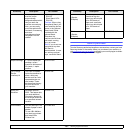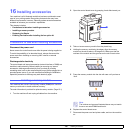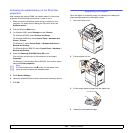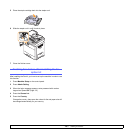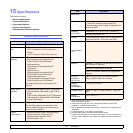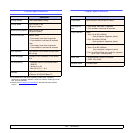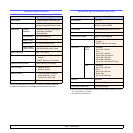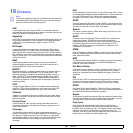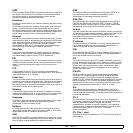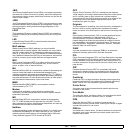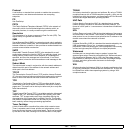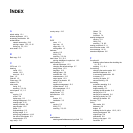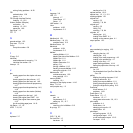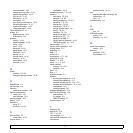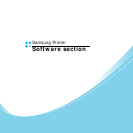
18.2 <
Glossary>
ECM
Error Correction Mode (ECM) is an optional transmission mode built
into Class 1 fax machines or fax modems. It automatically detects
and corrects errors in the fax transmission process that are
sometimes caused by telephone line noise.
Emulation
Emulation is a technique of one machine obtaining the same results
as another.
An emulator duplicates the functions of one system with a different
system, so that the second system behaves like the first system.
Emulation focuses on exact reproduction of external behavior, which
is in contrast to simulation, which concerns an abstract model of the
system being simulated, often considering its internal state.
Ethernet
Ethernet is a frame-based computer networking technology for local
area networks (LANs). It defines wiring and signaling for the physical
layer, and frame formats and protocols for the media access control
(MAC)/data link layer of the OSI model. Ethernet is mostly
standardized as IEEE 802.3. It has become the most widespread
LAN technology in use during the 1990s to the present.
EtherTalk
A suite of protocols developed by Apple Computer for computer
networking. It was included in the original Macintosh (1984) and is
now deprecated by Apple in favor of TCP/IP networking.
FDI
Foreign Device Interface (FDI) is a card installed inside the machine
to allow a third party device such as a coin operated device or a card
reader. Those devices allow the pay-for-print service on your
machine.
FTP
A File Transfer Protocol (FTP) is a commonly used protocol for
exchanging files over any network that supports the TCP/IP protocol
(such as the Internet or an intranet).
Fuser Unit
The part of a laser printer that melts the toner onto the print media. It
consists of a hot roller and a back-up roller. After toner is transferred
onto the paper, the fuser unit applies heat and pressure to ensure
that the toner stays on the paper permanently, which is why paper is
warm when it comes out of a laser printer.
Gateway
A connection between computer networks, or between a computer
network and a telephone line. It is very popular, as it is a computer or
a network that allows access to another computer or network.
Grayscale
A shades of gray that represent light and dark portions of an image
when color images are converted to grayscale; colors are
represented by various shades of gray.
Halftone
An image type that simulates grayscale by varying the number of
dots. Highly colored areas consist of a large number of dots, while
lighter areas consist of a smaller number of dots.
HDD
Hard Disk Drive (HDD), commonly referred to as a hard drive or hard
disk, is a non-volatile storage device which stores digitally-encoded
data on rapidly rotating platters with magnetic surfaces.
IEEE
The Institute of Electrical and Electronics Engineers (IEEE) is an
international non-profit, professional organization for the
advancement of technology related to electricity.
IEEE 1284
The 1284 parallel port standard was developed by the Institute of
Electrical and Electronics Engineers (IEEE). The term "1284-B"
refers to a specific connector type on the end of the parallel cable
that attaches to the peripheral (for example, a printer).
Intranet
A private network that uses Internet Protocols, network connectivity,
and possibly the public telecommunication system to securely share
part of an organization's information or operations with its
employees. Sometimes the term refers only to the most visible
service, the internal website.
IP address
An Internet Protocol (IP) address is a unique number that devices
use in order to identify and communicate with each other on a
network utilizing the Internet Protocol standard.
IPM
The Images Per Minute (IPM) is a way of measuring the speed of a
printer. An IPM rate indicates the number of single-sided sheets a
printer can complete within one minute.
IPP
The Internet Printing Protocol (IPP) defines a standard protocol for
printing as well as managing print jobs, media size, resolution, and
so forth. IPP can be used locally or over the Internet to hundreds of
printers, and also supports access control, authentication, and
encryption, making it a much more capable and secure printing
solution than older ones.
IPX/SPX
IPX/SPX stands for Internet Packet Exchange/Sequenced Packet
Exchange. It is a networking protocol used by the Novell NetWare
operating systems. IPX and SPX both provide connection services
similar to TCP/IP, with the IPX protocol having similarities to IP, and SPX
having similarities to TCP. IPX/SPX was primarily designed for local
area networks (LANs), and is a very efficient protocol for this purpose
(typically its performance exceeds that of TCP/IP on a LAN).
ISO
The International Organization for Standardization (ISO) is an
international standard-setting body composed of representatives
from national standards bodies. It produces world-wide industrial and
commercial standards.
ITU-T
The International Telecommunication Union is an international
organization established to standardize and regulate international
radio and telecommunications. Its main tasks include
standardization, allocation of the radio spectrum, and organizing
interconnection arrangements between different countries to allow
international phone calls. A -T out of ITU-T indicates
telecommunication.
ITU-T No. 1 chart
Standardized test chart published by ITU-T for document facsimile
transmissions.



